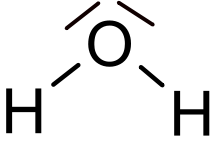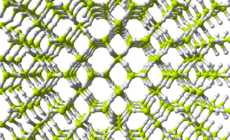Hydrogen polyoxide
Hydrogen polyoxides (also known as oxidanes, oxohydrogens, or oxyhydrogens) are chemical compounds that consist only of hydrogen and oxygen atoms, are bonded exclusively by single bonds (i.e., they are saturated), and are acyclic (have molecular structures containing no cycles or loops). They can, therefore, be classed as hydrogen chalcogenides.

The simplest possible stable hydrogen polyoxide (the parent molecule) is water, H2O. The general structure of the class of molecules is some number of oxygen atoms single-bonded to each other in a chain. The oxygen atom at each end of this oxygen skeleton is attached to a hydrogen atom. Thus, these compounds form a homologous series with chemical formula H
2O
n in which the members differ by a constant relative molecular mass of 16 (the mass of each additional oxygen atom). The number of oxygen atoms is used to define the size of the hydrogen polyoxide (e.g., hydrogen pentoxide contains a five-oxygen backbone).
An oxidanyl group is a functional group or side-chain analog of hydrogen polyoxide that is attached to some structure other than just a hydrogen atom. Examples include the hydroxy (oxidyl) and hydroperoxy (dioxidanyl) groups.
Specific examples
HOn
Several molecules are known where one end of the polyoxide chain is protonated and the other is an unprotonated radical:
- Hydroxyl (HO•)
- Hydroperoxyl (HOO•), the protonated form of superoxide
H2On
Neutral dihydrogen polyoxides containing up to five oxygen atoms have been produced experimentally.
- Water (H2O) is the most common hydrogen polyoxide, occurring widely on Earth's surface.
- Hydrogen peroxide (H2O2) is a common disinfectant and readily decomposes to form water and oxygen.
- Trioxidane (H2O3) is rare and readily decomposes into water and singlet oxygen.
- Hydrogen tetroxide (H2O4) has been synthesized by reaction among peroxy radicals at low temperature.[1]
- Hydrogen pentoxide (H2O5) is a byproduct of trioxidane production[2] and has also been synthesized by reaction among peroxy radicals at low temperature.[1]
Hydrogen polyoxides containing up to 10 oxygen atoms have been studied theoretically, but those containing more than five oxygens are expected to be extremely unstable.[3]
Ionization
All the hydrogen polyoxides are known or expected to autoionise when in liquid form, with the acidic hydrogen being solvated by other of the neutral polyoxide molecule(s).
- H2On ⇌ H+ + HOn–
- 2H2On ⇌ H3On+ + HOn–
See also
References
- Levanov, Alexander V.; Sakharov, Dmitri V.; Dashkova, Anna V.; Antipenko, Ewald E.; Lunin, Valeri V. (2011). "Synthesis of Hydrogen Polyoxides H2O4 and H2O3 and Their Characterization by Raman Spectroscopy". European Journal of Inorganic Chemistry. 2011 (33): 5144–5150. doi:10.1002/ejic.201100767.
- Xu, Xin; Goddard, William A., III (November 2002). "Peroxone chemistry: Formation of H2O3 and ring-(HO2)(HO3) from O3/H2O2". Proceedings of the National Academy of Sciences. 99 (24): 15308–15312. doi:10.1073/pnas.202596799.
- Martins-Costa, Marilia; Anglada, Josep M.; Ruiz-Lopez, Manuel F. (2011). "Structure, stability, and dynamics of hydrogen polyoxides". International Journal of Quantum Chemistry. 111 (7–8): 1543–1554. doi:10.1002/qua.22695.
- Huang, Peihao; Liu, Hanyu; Lv, Jian; Li, Quan; Long, Chunhong; Wang, Yanchao; Chen, Changfeng; Ma, Yanming (16 August 2019). "Metallic liquid H3O in a thin-shell zone inside Uranus and Neptune". arXiv:1908.05821.






